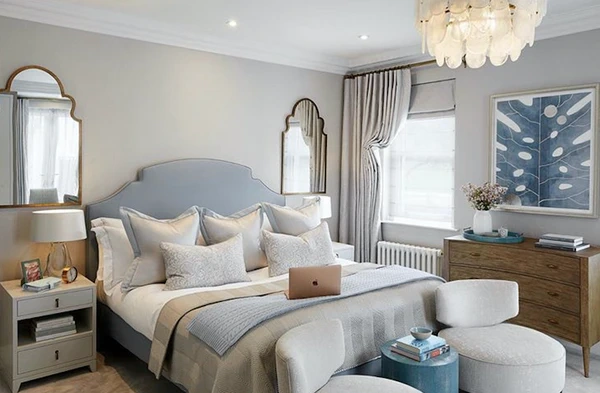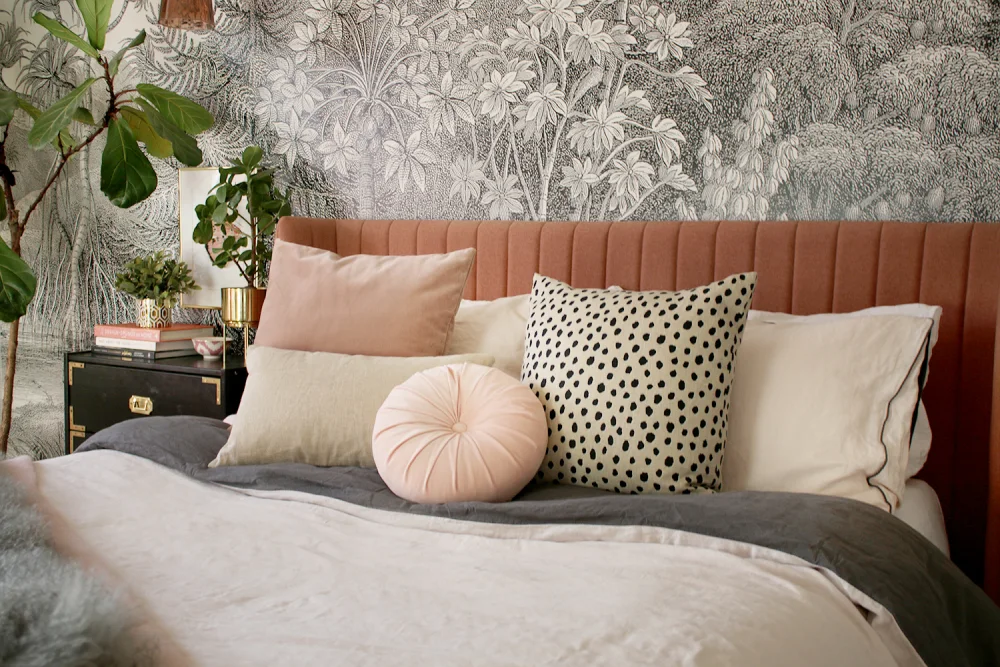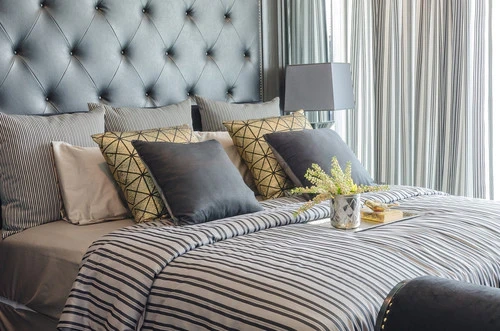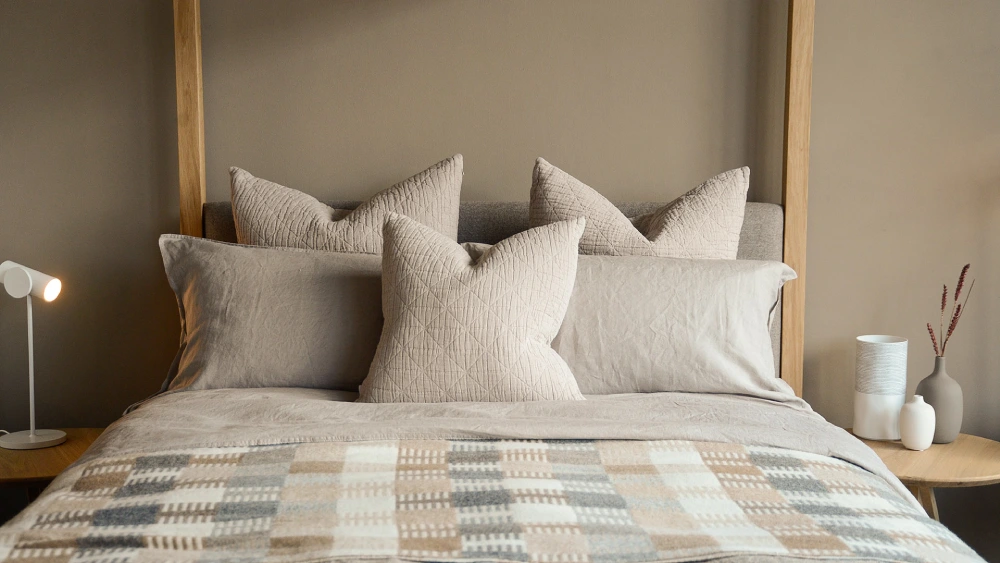Your bedroom is more than just a place to sleep it’s your sanctuary, your haven from the outside world. One of the most effective ways to elevate the ambiance and comfort of this sacred space is through decorative bed cushions. These small but impactful accessories have the power to transform a mundane bed into a luxurious retreat, adding both style and functionality to your bedroom decor.
Styles and Designs of Decorative Bed Cushions:
Decorative bed cushions come in a wide variety of styles, designs, shapes, and sizes to suit different tastes and preferences. Some common styles and designs include:
- Square Cushions: Square-shaped cushions are the most common type and are available in various sizes, ranging from small to large. They come in a myriad of colors, patterns, and fabrics, allowing for versatility in design choices.
- Rectangular Cushions: Rectangular cushions offer a different aesthetic compared to square cushions. They can be placed horizontally or vertically on the bed, adding visual interest and complementing the overall bedding arrangement.
- Bolster Cushions: Bolster cushions are cylindrical in shape and are often used as decorative accents at the head or foot of the bed. They provide additional support while also serving as stylish decor elements.
- Lumbar Cushions: Lumbar cushions are designed to support the lower back when sitting up in bed. They come in various shapes and sizes, with some featuring intricate designs or embellishments to enhance their decorative bed cushions appeal.
- Decorative Accents: Decorative bed cushions may feature various embellishments such as embroidery, beading, tassels, piping, or appliqué work. These embellishments add texture and visual interest to the cushions, making them stand out as focal points on the bed.
- Theme-Based Designs: Some decorative bed cushions are designed to complement specific themes or decor styles. For example, coastal-themed cushions may feature seashell or nautical motifs, while bohemian-inspired cushions may showcase vibrant colors and eclectic patterns.
Decorative Seat Cushions:
Decorative seat cushions are cushions designed primarily for aesthetic purposes, often used to enhance the visual appeal of seating arrangements such as chairs, sofas, benches, or even outdoor furniture. They come in various shapes, sizes, colors, patterns, and materials to suit different styles and preferences.
These cushions can be made from a wide range of materials including fabric, leather, faux fur, velvet, or even materials like woven straw or rattan for a more natural look. They may feature decorative bed cushions elements such as embroidery, tassels, fringe, sequins, beads, or printed designs to add flair and personality to the seating area.
Beyond their decorative function, seat cushions also provide additional comfort and support, making sitting for extended periods more pleasant. They can be used indoors in living rooms, bedrooms, or dining areas, as well as outdoors on patio furniture or garden benches.
Patchwork Cushions:
Patchwork cushions are decorative bed cushions made by sewing together small pieces of fabric in various designs to create a unique and visually appealing surface. The characteristics of patchwork cushions include:
- Variety of Fabrics: Patchwork cushions often feature a mix of fabrics in different colors, patterns, and textures, providing depth and interest to the final product.
- Creativity and Personalization: Each patchwork cushion is unique, allowing crafters to showcase their creativity by selecting fabric combinations and arranging them in distinctive patterns.
- Traditional and Contemporary Appeal: Patchwork techniques have a rich history rooted in traditional quilting practices, but they also offer opportunities for modern interpretations and designs.
- Versatility: Patchwork cushions can complement various interior design styles, from rustic and vintage to eclectic and contemporary, making them versatile decorative accessories for any space.
Techniques Involved:
Creating patchwork cushions involves several techniques that combine sewing, quilting, and design skills. Some of the key techniques include:
- Fabric Selection: Choose a variety of fabrics in different colors, patterns, and textures that complement each other and suit the desired aesthetic.
- Cutting: Cut the selected fabrics into small shapes or pieces, such as squares, rectangles, triangles, or any other desired shapes, using fabric scissors or rotary cutters.
- Arrangement: Arrange the fabric pieces in a pleasing design or pattern. This can be done randomly for a scrappy look or in a structured design for a more organized appearance.
- Sewing: Sew the fabric pieces together using a sewing machine or hand stitching, leaving seam allowances as necessary. Seam allowances are typically 1/4 inch or 1/2 inch, but this can vary depending on the project.
- Pressing: Press the seams open or to one side using an iron to create a flat and neat surface.
- Quilting (Optional): Quilting involves stitching through the top fabric, batting, and backing fabric to create a quilted effect. This step is optional but can add texture and dimension to the patchwork cushion.
- Finishing: Trim any excess fabric, square up the edges, and add backing fabric to complete the cushion. Depending on personal preference, closures such as zippers, buttons, or envelope closures can be added to finish the cushion cover.
Printed Cushions:
Printed cushions refer to patterns, images, or graphics that are transferred onto various surfaces through printing techniques. These designs can be found on textiles, paper, ceramics, plastics, and more. They serve aesthetic, functional, and communicative purposes, adding visual interest and conveying messages or artistic expressions.
Printed cushions can be created through various methods, including traditional techniques like screen printing, block printing, and lithography, as well as modern digital printing technologies such as inkjet and dye-sublimation printing. The choice of method often depends on factors such as the desired outcome, the material being printed on, cost considerations, and production scale.
Printed cushions are ubiquitous in everyday life, appearing on clothing, interior décor, packaging, advertising materials, and art pieces. They play a significant role in branding, fashion, art, and design industries, contributing to the visual landscape of our surroundings.
Printing Methods:
- Screen Printing: Involves creating a stencil (screen) and using it to apply layers of ink onto a surface through a mesh screen. Each color requires a separate screen, making it suitable for simple designs with few colors.
- Digital Printing: Utilizes computer-controlled printing machines to directly apply ink onto the substrate. It offers high-quality, detailed prints with virtually unlimited color options and is ideal for complex designs or small production runs.
- Block Printing: This involves carving a design into a block of wood, linoleum, or other materials, which is then inked and pressed onto the surface. It’s a traditional method that allows for handmade, unique prints but is time-consuming and best suited for small-scale production.
- Lithography: Based on the principle that oil and water don’t mix, lithography uses a flat surface (typically a metal plate) where the design is drawn or transferred using greasy materials. The surface is then treated so that ink adheres only to the design, which is then transferred onto the substrate.
- Flexography: Commonly used in packaging and labeling, flexography employs flexible relief plates and fast-drying inks. It’s suitable for printing on various substrates, including paper, plastics, and films, at high speeds.
Popular Motifs and Themes:
Printed designs encompass a wide range of motifs and themes, reflecting cultural, artistic, and commercial influences. Some popular motifs and themes include:
- Floral Patterns: Inspired by nature, floral designs feature various flowers, leaves, and botanical elements. They evoke feelings of beauty, femininity, and nostalgia, and are commonly used in fashion, home décor, and stationery.
- Geometric Designs: Characterized by geometric shapes such as triangles, circles, squares, and hexagons, geometric patterns offer a modern, minimalist aesthetic. They are versatile and suitable for both contemporary and traditional applications.
- Animal Prints: Mimicking the patterns found in animal skins or fur, animal prints add a bold, exotic touch to designs. Leopard, zebra, and snakeskin prints are particularly popular in fashion and interior décor.
- Abstract Art: Abstract designs feature non-representational forms, colors, and textures, allowing for creative expression and interpretation. They are often used in modern art, textiles, and graphic design to convey emotion and energy.
- Cultural Motifs: Drawing from diverse cultural traditions and symbolism, cultural motifs add depth and significance to printed designs. Examples include paisley patterns, tribal motifs, and motifs inspired by indigenous art.
Embroidered Cushions:
Embroidery cushions are a popular way to add decorative flair and personalization to home decor. It involves stitching various designs, patterns, and motifs onto cushion covers using needle and thread. This form of embellishment can range from simple stitches to intricate designs, making it versatile for different styles and preferences. Embroidered cushions can enhance the aesthetic appeal of living spaces, adding texture, color, and visual interest to sofas, chairs, beds, and other seating areas. Additionally, embroidered cushions can also serve as meaningful gifts, heirlooms, or cherished handmade items within families.
Types of Embroidery Techniques:
- Cross-Stitch: One of the most popular techniques, involving X-shaped stitches to form a pattern or design.
- Crewel Embroidery: Traditionally done with wool on linen fabric, featuring bold, intricate designs often depicting flora, fauna, or geometric patterns.
- Chain Stitch: A looped stitch forming a chain-like pattern, commonly used for outlining and filling shapes.
- Satin Stitch: A flat stitch used for filling shapes or creating smooth, solid areas of color.
- French Knots: Small, raised knots used to add texture and detail to designs.
- Embroidery Appliqué: Involves stitching fabric pieces onto a base fabric to create designs or patterns.
- Couching: Technique where one thread is laid on the fabric surface and another thread is used to hold it in place with small stitches.
- Embroidery Beading: Adding beads and sequins to embroidery designs for embellishment and texture.
- Blackwork Embroidery: A monochromatic style typically done with black thread on white or light-colored fabric, featuring geometric patterns or motifs.
- Crewel Work: Similar to crewel embroidery but often includes a variety of stitches and is worked on heavier fabrics like twill or velvet.
Cultural Significance:
- Embroidery on cushions holds cultural significance across various regions and societies:
- Traditional Craft: In many cultures, embroidery is a traditional craft passed down through generations, with each region having its own distinct styles, motifs, and techniques.
- Symbolism: Embroidered designs often carry symbolic meanings, representing cultural heritage, beliefs, rituals, or stories.
- Identity and Heritage: Embroidery on cushions can reflect the identity and heritage of a particular community or ethnic group, showcasing their artistic traditions and craftsmanship.
- Celebrations and Festivals: Embroidered cushions may be created for special occasions such as weddings, festivals, or religious ceremonies, serving as decorative elements or gifts exchanged during celebrations.
- Economic Empowerment: In some regions, embroidery serves as a source of income for artisans, particularly women, providing economic empowerment and preserving traditional craftsmanship.
- Global Influence: With globalization, traditional embroidery techniques are sometimes adapted and integrated into contemporary designs, leading to a fusion of cultural influences in embroidered cushion designs.
Silk Cushions:
Silk cushions offer a luxurious touch to any space with their soft texture and elegant appearance. Here are some features, benefits, and care tips for silk cushions:
Features of Silk Cushions:
- Softness: Silk cushions are renowned for their incredibly soft texture, providing a comfortable surface for relaxation.
- Elegance: Silk fabric exudes sophistication and adds a touch of luxury to any room. The smooth surface of silk enhances the visual appeal of cushions.
- Hypoallergenic: Pure silk is naturally hypoallergenic, making silk cushions a great choice for individuals with allergies or sensitive skin.
- Temperature Regulation: Silk has natural temperature-regulating properties, keeping you cool in summer and warm in winter, ensuring year-round comfort.
- Durability: High-quality silk cushions can be durable if properly cared for, maintaining their beauty and softness for years.
- Luxurious Appeal:
-
-
- Silk cushions instantly elevate the ambiance of a room, adding a touch of opulence and sophistication.
- The sheen and smooth texture of silk create a luxurious focal point in any space, whether it’s a living room, bedroom, or formal sitting area.
- The vibrant colors and delicate patterns available in silk fabrics further enhance their luxurious appeal, making them a versatile choice for various interior design styles.
-
- Care and Maintenance:
-
- Dry Cleaning: Silk cushions are typically recommended for dry cleaning to preserve their delicate fibers and prevent damage. Professional dry-cleaning ensures thorough cleaning without risking fabric shrinkage or color fading.
- Spot Cleaning: For minor stains or spills, gently spot-clean the affected area with a mild detergent and water solution. Avoid rubbing vigorously, as this can damage the silk fibers.
- Avoid Direct Sunlight: Direct sunlight can fade silk fabric over time, so it’s best to place silk cushions away from windows or use window treatments to protect them from UV rays.
- Handle with Care: Silk is a delicate fabric, so handle silk cushions with care to prevent snags or tears. Avoid sharp objects or rough surfaces that could damage the fabric.
- Storage: When not in use, store silk cushions in a cool, dry place away from direct sunlight and moisture. Avoid storing them in plastic bags, as this can trap moisture and lead to mildew growth.
Choosing the Right Decorative Bed Cushions:
Considerations for Selecting Cushions:
- Comfort: Prioritize comfort when selecting decorative bed cushions, ensuring they provide adequate support.
- Material: Choose materials that complement the overall aesthetic and are easy to maintain.
- Size and Shape: Consider the dimensions of your furniture and select decorative bed cushions that fit well without overwhelming the space.
- Durability: Opt for durable fabrics and construction, especially for high-traffic areas.
- Color and Pattern: Coordinate with existing decor or use cushions to introduce accent colors and patterns.
- Texture: Incorporate different textures to add depth and visual interest to your space.
Matching Cushions with Decor:
- Color Scheme: Select decorative bed cushions that complement or contrast with the dominant colors in the room’s decor.
- Theme or Style: Ensure cushions align with the overall theme or style of the room, whether it’s modern, traditional, eclectic, etc.
- Pattern Coordination: Coordinate patterns with other elements in the room, such as curtains, rugs, or upholstery, to create a cohesive look.
- Balance: Maintain a balance between solid colors and patterns to avoid overwhelming the space.
- Seasonal Considerations: Swap out cushions seasonally to reflect changing color palettes or themes.
Mixing and Matching Different Types:
- Size Variation: Experiment with different sizes of cushions to create visual interest and depth.
- Texture Contrast: Mix textures like velvet, linen, or wool to add dimension to your seating area.
- Pattern Play: Combine different patterns, such as stripes, florals, or geometric designs, while ensuring they complement each other.
- Color Contrast: Introduce contrast through complementary or contrasting colors to make your cushions pop.
- Layering: Layer cushions of varying sizes, shapes, and textures to create a cozy and inviting seating arrangement.
- Personalization: Don’t be afraid to showcase your personality by incorporating unique or eclectic cushions that reflect your style preferences.
Conclusion:
Decorative bed cushions are versatile accessories that can instantly transform the look and feel of your bedroom. Whether you prefer bold and vibrant or soft and understated, there’s a wide range of options available to suit every style and preference. By experimenting with color, texture, pattern, size, and shape, you can create a personalized and inviting sleep sanctuary that reflects your unique personality and aesthetic sensibilities. So go ahead, unleash your creativity, and elevate your bedroom decor with the simple addition of decorative bed cushions.




